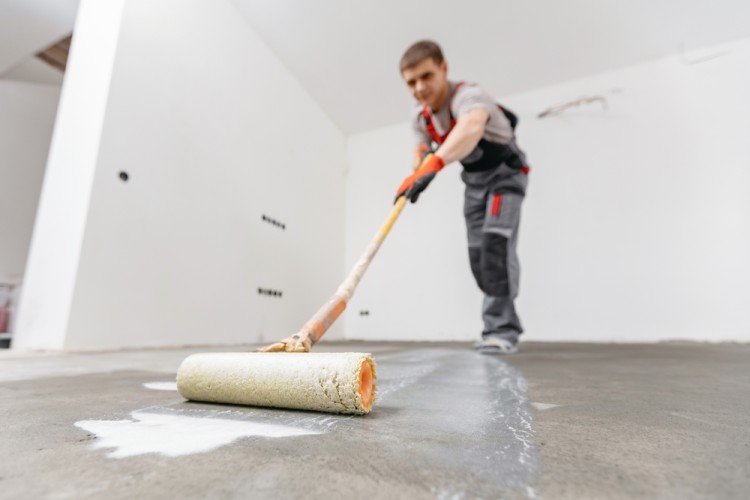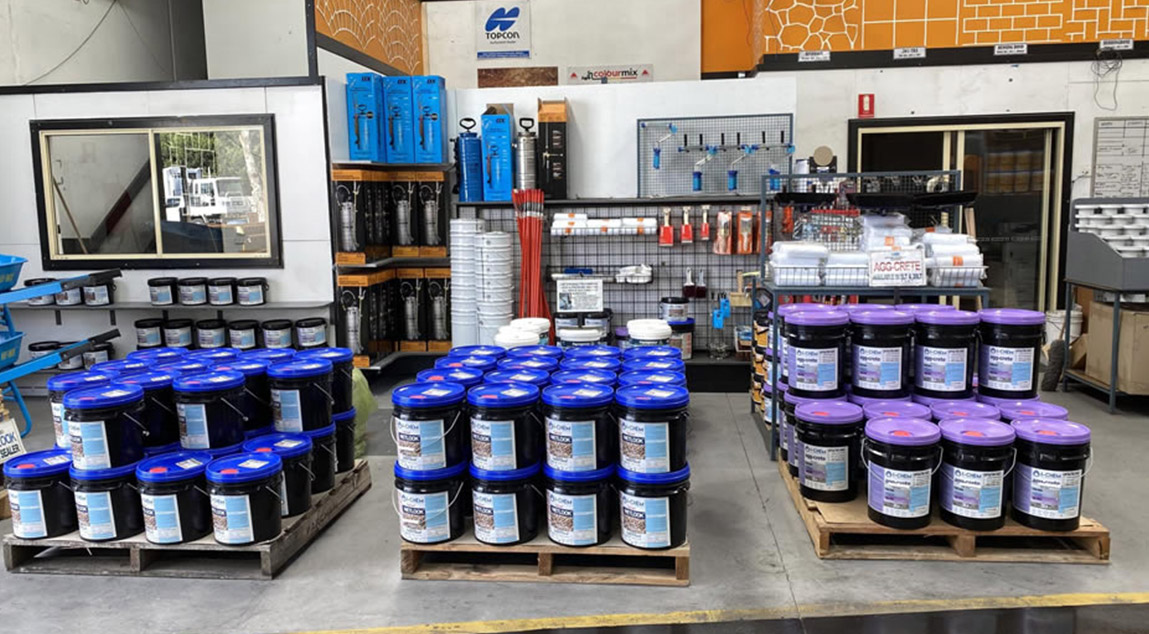Best Practices for Applying Water-Based Concrete Sealer

Concrete is a common sight – it makes up our paths, driveways and garage floors, and is even seen inside both homes and commercial businesses. Whether it’s foot traffic or cars, concrete is designed to withstand a lot of damage, but as a porous material, how can we help our beautiful concrete surfaces stay in good condition?
Applying a sealer to your concrete is a great way to protect it from damage and decay, as well as giving it a boost in looks. You can seal both new or old concrete, but it can be tricky to know which sealer products to choose when it’s time to bolster your concrete’s defences.
A water-based concrete sealer is long-lasting, easy to apply, and the perfect choice for bringing out the natural colours and design of the surface. But like with any concrete project, there are some steps you should follow to get the most out of your sealer and ensure your concrete looks the best it can be.
Keep the following tips in mind when concrete sealing using a water-based product.
Why Choose A Water-Based Concrete Sealer?
You might want to go for solvent-based concrete sealers due to their gloss, but they are known for having a strong odour, containing abrasive chemicals and not lasting too long before needing a new coating. Here are a few reasons why water-based concrete sealers are an excellent choice:
- Environmentally friendly: Volatile Organic Compounds (VOCs) are released by solvents when they evaporate into the atmosphere. While these are highly present in solvent-based sealers, water-based concrete sealers have none, or at least a very low amount. This makes them safer to dispose of and much more pleasant to work with.
- Long-lasting: Water-based concrete sealers are very durable and able to withstand heavy traffic and the staining effects of dirt, food, drink, chemicals and grease. You can use them in busy areas like the garage, footpaths, around your pool or in the garden and enjoy their protective effect for many years.
- Colour enhancing: This type of sealer will highlight the natural colour of your concrete, making it more vibrant without adding a sheen or high gloss like a solvent-based sealer would. If you have beautiful concrete you want to show off with a matte finish, a water-based sealer is perfect for the job.
- Washes up with water: If you get this solvent on your skin or excess sealer spreads where you don’t want it – don’t stress! You can clean it up with water, but this must be done while the solvent is still wet. If you wait until it is dry, you will need to remove it with a concrete stripper or a pressure washer.
- UV resistant: You won’t need to worry about water-based sealer being weakened by the sun! This sealer can resist the yellowing, cracking and fading effects of UV rays, while protecting your concrete from this damage at the same time.
- Easy to apply: This type of concrete sealer is easy to apply without professional help. You can use a sprayer or a roller brush/broom to apply it evenly across your surface for complete coverage, and with no nasty fumes to worry about, you’ll find the application process easy to take your time with and do right the first time.
Now that you’ve chosen your water-based concrete sealer, here are some best practices for applying it.
You can learn more about the types of sealers in the blog, ‘Exploring The Different Types Of Sealers For Concrete.’
Make Sure Your Concrete Surface Is Clean And Dry
Use a pressure washer or hose set to moderate intensity to give your concrete floor a good clean. You’ll want to remove dirt, dust and any old vegetation from the surface before starting the sealing process, as once these things get trapped under your sealant they won’t be coming out! If you have old stains, you may need to use a concrete degreaser or cleaner to remove them.
Make sure to wait until the surface has dried and use this time to inspect it for any cracks or chips. These should be repaired using a concrete filler, left to dry and then sanded flat so you have a smooth, whole surface to work on when it’s time to add the sealer.
Clean your concrete surface with a pressure cleaner from Australian Slate Crete Supplies’ range of power tools.

Use The Right Tool To Apply The Water-Based Concrete Sealer
When using your water-based concrete sealer, it’s always important to use the right application method. We recommend using a paint roller brush or broom to slowly apply the sealant in thin, even layers across your surface, as it allows you to get into the corners easier than you would with a sprayer to achieve maximum coverage.
Don’t pour out huge puddles – small ribbons of sealer are the most appropriate application method. Use your tool to apply the sealer up and down, left to right in a cross pattern across the whole surface for an even coating. Make sure that the first coat stays clean, then remove any debris that makes its way onto the concrete quickly before the sealer sets.
You can find a great range of concrete hand tools, like finishing brooms, rakes, screeds, and more at Australian Slate-Crete Supplies.
Apply Two Coats Of Sealer
Once the first coat has dried (drying times can take anywhere between 6-12 hours), apply another thin coat of sealer. Make sure the surface is still clean before you start, then add the second coat in the same manner as you did the first, aiming for complete coverage. If your concrete surface is particularly porous and absorbent, you may even need to add a third coating.
Let your final coat dry completely before you start using the concrete again. Drying times can vary, and it may take a day or two, depending on the weather conditions. If you wish to drive your car over the newly-sealed concrete, wait at least three days to be safe.
Reapply Every 5 Or So Years
Water-based concrete sealers have a longer life than their solvent counterparts. If applied correctly, you shouldn’t need to reapply a new coat for another five or so years. Of course, this life will depend on how well you maintain your concrete surface.
Quickly cleaning up any dangerous spills will prevent them from weakening your sealer – this is important if you work with strong chemicals and acids that could damage your concrete. You should also keep the surface free from rocks, sticks and other sharp debris that can damage the concrete if walked or driven over repeatedly – while your sealer will resist damage for a while, it’s not impervious to repeated impacts.
Make sure the surface is smooth and clean before applying a new coat. A simple wash may be all that’s needed, or you may need to use fine sandpaper to smooth down any rough edges that have come up.

Choose Us When You Need Concrete Sealer Supplies In Melbourne
Do you want to protect and enhance your concrete with a water-based sealer? Australian Slate-Crete Supplies is your best source of concrete sealers in Melbourne and across Australia. Having served our clients with quality supplies and advice for over 25 years, we are passionate about helping our DIY customers get the job done on their first try.
Discover more information about the Differences Between Solvent And Water-Based Sealers from our blog. Alternatively, feel free to call us at 03 9408 7722 and chat with an expert about our range of high-quality sealers for Australia’s properties. Every product is extensively tested to ensure it can withstand our harsh weather and climate.
-
 February 4, 2022Sandstone Concrete Stencil
February 4, 2022Sandstone Concrete StencilDo you want to add a touch of luxury and elegance to your concrete projects? If so, then consider using sandstone concrete stencils!
Read More -
 February 4, 2022Gloss Brick Sealer
February 4, 2022Gloss Brick SealerGloss brick sealer is a wonderful material for adding a brilliant shine to your brick slip wall feature.
Read More -
 February 4, 2022Bluestone Concrete Sealer
February 4, 2022Bluestone Concrete SealerIn a broad sense, the term “bluestone” is sometimes used to refer to a variety of stones. It’s a marketing term rather than a geological one.
Read More
